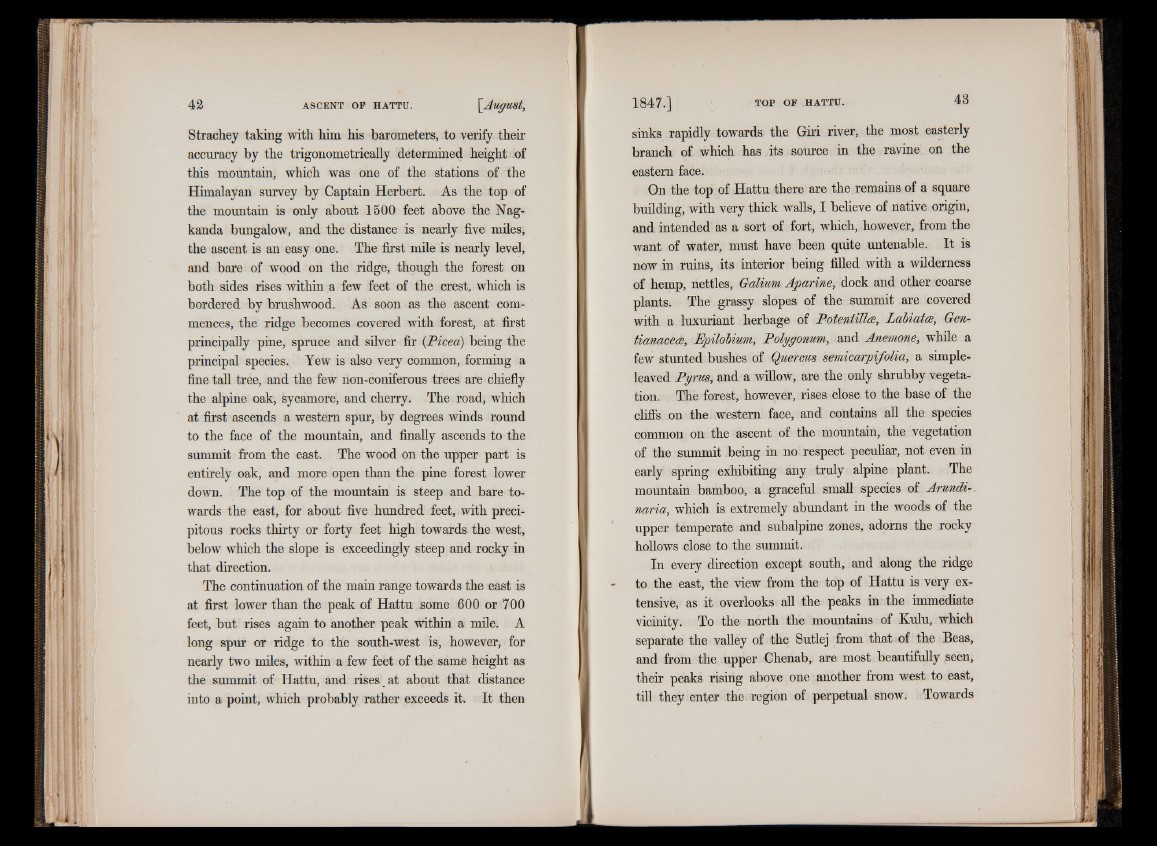
Strachey taking with him his barometers, to verify their
accuracy by the trigonometrically determined height of
this mountain, which was one of the stations of the
Himalayan survey by Captain Herbert. As the top of
the mountain is only about 1500 feet above the Nag-
kanda bungalow, and the distance is nearly five miles,
the ascent is an easy one. The first mile is nearly level,
and bare of wood on the ridge, though the forest on
both sides rises within a few feet of the crest, which is
bordered by brushwood. As soon as the ascent commences,
the ridge becomes covered with forest, at first
principally pine, spruce and silver fir (Picea) being the
principal species. Yew is also very common, forming a
fine tall tree, and the few non-coniferous trees are chiefly
the alpine oak, sycamore, and cherry. The road, which
at first ascends a western spur, by degrees winds round
to the face of the mountain, and finally ascends to the
summit, from the east. The wood on the upper part is
entirely oak, and more open than the pine forest lower
down. The top of the mountain is steep and bare towards
the east, for about five hundred feet, with precipitous
rocks thirty or forty feet high towards the west,
below which the slope is exceedingly steep and rocky in
that direction.
The continuation of the main range towards the east is
at first lower than the peak of Hattu some 600 or 700
feet, but rises again to another peak within a mile. A
long spur or ridge to the south-west is, however, for
nearly two miles, within a few feet of the same height as
the summit of Hattu, and rises at about that distance
into a point, which probably rather exceeds it. It then
sinks rapidly towards the Giri river, the most easterly
branch of which has its source in the ravine on the
eastern face.
On the top of Hattu there are the remains of a square
building, with very thick walls, I believe of native origin,
and intended as a sort of fort, which, however, from the
want of water, must have been quite untenable. It is
now in ruins, its interior being filled with a wilderness
of hemp, nettles, Galium Aparine, dock and other coarse
plants. The grassy slopes of the summit are covered
with a luxuriant herbage of Potentillce, Labiate, Gen-
tianacece, Ppilobium, Polygonum, and Anemone, while a
few stunted bushes of Quercus semicarpifolia, a simpleleaved
Pyrus, and a willow, are the only shrubby vegetation.
The forest, however, rises close to the base of the
cliffs on the western face, and contains all the species
common on the ascent of the mountain, the vegetation
of the summit being in no respect peculiar, not even in
early spring exhibiting any truly alpine plant. The
mountain bamboo, a graceful small species of Arundi
naria, which is extremely abundant in the woods of the
upper temperate and subalpine zones, adorns the rocky
hollows close to the summit.
In every direction except southland along the ridge
to the east, the view from the top of Hattu is very extensive,
as it overlooks all the peaks in the immediate
vicinity. To the north the mountains of Kulu, which
separate the valley of the Sutlej from that of the Beas,
and from the upper Chenab, are most beautifully seen,
their peaks rising above one another from west to east,
till they enter the region of perpetual snow. Towards